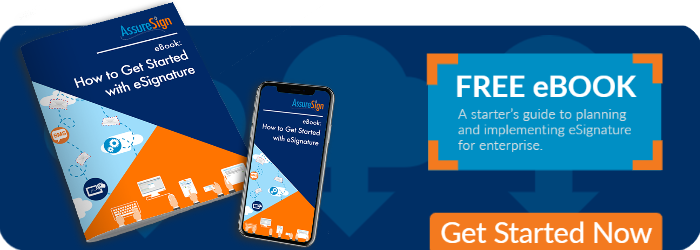Electronic signatures have been legal in the United States for over 20 years…
In fact, the turn of the millennium, or sometime close to it, marks the start of many countries legally accepting some type of virtual signature.
In its infancy, eSignatures were considered a business luxury. Yet in 2020, electronic signatures have become widely recognized as an essential driver of today’s modern marketplace. Not only do electronic signatures add convenience and enhanced security to B2B and B2C transactions, it dramatically reduces cost.
Captorra, the legal industry’s leading case and client intake software solution, reduced cost by over 90 percent after adopting electronic signatures (electronic signature for text message to be specific).
Other enterprises, like United BioSource Corporation (UBC) who can now offer critical medical care to patients in hours instead of days, rely on the timing advantages of the eSign.
Despite its crucial impact on today’s enterprises, many are still unfamiliar with what electronic signature is, how it accelerates and secures modern transactions, and its overall impact on go-to-market strategies in a digital era.
But even more importantly, many are still unaware of the differences between electronic signatures and their virtual counterpart, digital signatures. But before we dive into the difference between digital signature and electronic signature, let’s start from the top… “ What is electronic signature?”
Electronic Signature Defined
In the United States, electronic signature enjoys a rather inclusive definition:
“An electronic sound, symbol or process that is attached to or logically associated with a record and executed or adopted by a person with the intent to sign the record.”
Now you may be wondering if it can truly be any symbol, process... even sound?! Perhaps you’re considering what goes into a “sound, symbol, or process” that can be well-documented.
Put simply, AssureSign utilizes a string of virtual “fingerprints,” such as hash markers and IP identifiers, to verify a signer’s identity and “intent” to sign a document. These fingerprints are digitally tied to the signing process and associated documents.
So, when a document is signed electronically, it is considered 100% legally binding… whether it’s with a recorded verbal acknowledgement, a keystroke, the swipe of a stylus, or even a selected checkbox.
Electronic signatures are easily implemented into existing processes and eliminate a lot of legwork on behalf of consumers and businesses. Yet, electronic signatures are not the only type of virtual signature available to consumers…
Digital Signature vs. Electronic Signature
The difference between digital signature and electronic signature is largely found in the method of identifying businesses and signers.
Digital signatures embed what’s called “Personal Key Infrastructure” (PKI) into the signing process as a way to identify both the party requesting a signature and the party providing one.
In short, PKI generates two keys, one public and one private, to uniquely identify a signer. However, both you and your signer must have a registered digital certificate from an issuing certificate authority to link the signer and their signature.
Here’s an example of how the process would work…
Obamaha, Inc. needs Beth to sign a contract renewal. During the process, Beth signs the contract using her private key, which is then encrypted. Beth also provides Obamaha, Inc. with her public key. If the public key provided cannot decrypt Beth’s signature, it’s invalid.
In this case, Beth’s digital certificate (her public and private keys) identifies her much like a driver’s license or passport would.
This process of identifying signers and originators is the primary difference between electronic signature and digital signature.
While both electronic signature and digital signature are equally capable of identifying a signer and capturing legal signatures… many consumers do not have a digital signature certificate, meaning they’re unable to provide digital signatures.
Why Electronic Signature (vs Digital Signature)?
Because both electronic and digital signatures are equally secure and legal forms of signatures-thanks to the UETA and ESIGN acts-many businesses opt for the convenience and versatility of eSignature.
With eSignature, businesses can:
- Verify the identity of their signers
- Associate the necessary identifiers with the signing process
- Safely capture a legal and binding signature
- Easily retain and store completed documents
… all without the hassle and cost of digital certificates!
When considering electronic signature vs digital signature, businesses know that vendors like AssureSign utilize a robust cybersecurity framework to verify, capture and safeguard sensitive data.
AssureSign Keeps Your Data Safe...

From SMBs to large enterprises like the U.S. Olympics and AAA, businesses across the globe trust AssureSign to provide a higher standard of signature flexibility, versatility and security.
AssureSign’s Security and Legal Commitment to customers and signers guarantees a robust safeguarding of documents and data. With industry-leading technology like the 256-bit encryption standard, AssureSign employs a multi-layered encryption and security protocol, which maintains the integrity of your data’s security both at rest and in motion.
What’s more, a digital audit trail is created for every document you send. The value of a digital audit trail is twofold. It incorporates meta data that (1) secures your documents and (2) provides evidence of signer identification and activity concerning your documents.
Examples of collected data helping to identify signers:
- IP Addresses
- OS and Browser Information
- Geo Coordinates
- Time & Date Stamps
These and other identifiers/metadata enable the audit trail to confirm a signer’s identity while validating his or her input and signatures on the document(s). Further, the audit trail includes the document’s hash value, which prevents the documents from being altered or tampered with.
Discover how your business can begin benefiting from electronic or digital signatures today…

** This article was originally authored by Jackson Tyler Burke while employed with AssureSign, LLC. All copyright and publishing rights for this article and its contents are retained by AssureSign, LLC.
